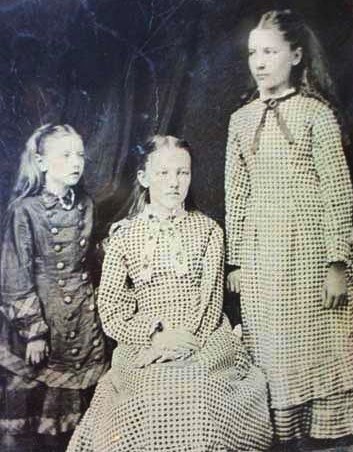Laura Ingalls Wilder, right, with her sisters Mary (seated) and Carrie circa 1881. Courtesy of the Laura Ingalls Wilder Home Association
Politico Magazine, September 11, 2016

For 84 years, American kids have been growing up with Laura Ingalls Wilder’s inspiring Little House books, reading brave tales of survival on the prairies in the 19th century. The saga tells of a pioneer girl’s itinerant childhood traveling in covered wagons and starting new farms across the prairies—from Wisconsin to American Indian lands, Minnesota and Dakota Territory. She courageously helps her family fight fires, blizzards and drought; she helps bring in the cows, dress a blackbird for supper and twist hay for the cookstove. Both in the books and the popular TV show “Little House on the Prairie,” the Wilder family stories have become perhaps our most iconic portraits of the optimism and self-reliance of the frontier.
In modern America they also seem like escapism—a welcome relief from the welter and conflict of today’s politics. Actually they’re anything but. The Little House books, conceived during the Great Depression as a family project to honor the nation’s tough old pioneers, blossomed during the writing into something else. Woven into the story of Laura’s life were then-new ideas about the value of individual freedom, unfettered markets and limited government. During the writing of each new book, as the series expanded in answer to the fans’ clamors for more, the Little House books became anti-New Deal political parables. They helped lay the groundwork for the modern libertarian strain of modern conservatism—and to an extent few people realize, they helped fund its rise.
The Little House books, still in print with HarperCollins, began with Little House in the Big Woods and ended with These Happy Golden Years. Wilder’s silent collaborator in all of them was her daughter, Rose Wilder Lane—a famous writer in her time and a key early organizer of the libertarian political movement starting in the 1930s. Rose helped shape the books as she helped her mother get the stories down on paper, turning them—with her mother’s cooperation—from straight memoir into a kind of sustained allegory of American freedom.
Amid the images of stoic optimism displayed by the Ingalls and Wilder families as they ride through storms and survive locust plagues, the authors deliver little lessons in vignettes and dialogue, extolling free-market economics (“You work hard, but you work as you please. … You’ll be free and independent, son, on a farm”) and raising skepticism about government overreach (“Why do they make a law that he’s got to stay on a claim, when he can’t?”). For a country in the throes of the Depression, the Little House books delivered a clear and consistent message about the virtues of rugged individualism and not taking handouts from Washington.
For the American conservative movement, the books were part of a big shift, away from emphasizing wealth and toward emphasizing the power of the individual to do what he or she wants. Lane was one of the intellectual architects of the shift: aside from being the books’ co-author, she was an influential free-market activist, economic thinker and acquaintance of Ayn Rand. She wrote essays and book reviews in favor of free markets and against government programs; she refused a ration card during World War II and grew and canned most of her food at her Danbury, Connecticut, house. She kept a hand in conservative thinking until her death in 1968.
Her mother, Laura Ingalls Wilder, was not a politically oriented talker, or much of a public figure at all, but from her comments we know she saw her life story as helping shape America’s sense of itself. And far beyond that, the books’ influence continued to shape politics. With the comfortable income provided by the Little House royalties, Rose helped fund a free-market academy in Colorado called the Freedom School. Two of the people who attended the school were perhaps the most profoundly influential donors in modern conservativism: Charles and David Koch.
The story of how Little House—one of the most beloved series of books in American history—entwined itself with the growth of free-market conservatism is one of the most dramatic, and little-appreciated, examples of the way literature can shape national politics. It might not be quite true that the Little House stories built the conservatism we know today, but it surely wouldn’t be the same without them.
***
The eight original titles in Wilder’s series (Little House in the Big Woods, Little House on the Prairie, Farmer Boy, and the rest, published between 1932 and 1943) retold the story of 19th-century farming families to an audience of early 20th-century families then struggling with lost investments, job loss and a multiyear drought. The books came out just when the old pioneers were remembering their hardships and expressing anger that Americans thought they needed the New Deal.
Though the books carried the name of just one author, behind them was an unusual collaborative relationship. Laura Ingalls Wilder was herself one of those tough former pioneers. She had endured a lot of hard times. By age 13, she had moved six times. She married a farmer and, after heartbreaking disasters in Dakota Territory (told about in the unedited book published after her death, The First Four Years) raised chickens and fruit with him in Missouri. In middle age, Laura began writing essays for a farm paper. A lifelong storyteller, she’d long wanted to write down her life, but she relied on her daughter Rose Wilder Lane to help her frame, structure and polish her writing. Rose pressed her to first write a long memoir (an annotated version, Pioneer Girl, was published last year).
Lane knew writing and publishing. Before working with her mother on the Little House books, she had been a journalist, best-selling fiction writer for big magazines and book author—she wrote a dramatic and glowing campaign biography of Herbert Hoover in 1920. She had helped many of her writer friends polish their work. She’d lived in France and Albania and visited Russia in the early years of its communist government. During the Little House collaboration, Rose published two pioneer novels for adults (Let the Hurricane Roar and Free Land).
As the Little House books took form, evolving from personal reminiscence to carefully crafted fiction, they took on a subtle but consistent ideological cast—an optimistic take on pioneer times that showed struggling settlers making decisions based on their desire to follow the Declaration of Independence. This political cast isn’t just a literary interpretation, and it was no accident. Laura Ingalls Wilder was herself a political conservative, suspicious of the handouts of the New Deal. And her daughter was more ideologically driven. For Rose, self-reliance was an ethic she learned growing up, and it became an intellectual principle she fixed upon through extensive reading. (For all her sophistication and impressive connections, she was a self-taught intellectual whose schooling had ended in roughly ninth grade.) Rose kept detailed diaries for many years and wrote hundreds of letters to friends and to her mother. It’s clear from these documents, which I’ve examined carefully, that Rose exerted a heavy editing and framing hand on her mother’s books.
It’s not hard to detect this impulse to celebrate individual freedom in the books, and it often appears in almost didactic form—“Don’t forget that every one of us is free and independent, Loftus,” Pa lectures a storekeeper in an argument over wheat profits during a winter famine. In Little Town on the Prairie, Laura, then a young teenager, has an epiphany about being responsible for herself after she hears a speech about independence at a Fourth of July ceremony. Elsewhere, the books minimize the role of government in the life of a family that sometimes did have to rely on it, as they took free land and benefited from state funds that paid sister Mary Ingalls’s tuition at the Iowa School for the Blind for seven years, a public subsidy the books quietly omit.
During the years they worked together, Lane—we know from her diaries, idea notebooks and letters to friends—began to think seriously about the relationship between the family’s farming roots and what makes America strong. Both Wilder and Lane thought that the solution to the Great Depression was to let people ride it out and learn to get by on less. The resulting books were best-sellers that celebrated the power of the individual over the government as an American principle just when that debate was raging over Franklin D. Roosevelt’s New Deal.
These ideas fit with an anti-government-regulation movement that was beginning to light a fire under political conservatives. And they reached more readers with those ideas than a political manifesto could ever have done.
***
***
The Little House books were also very lucrative. The yearly income from book royalties is unknown, but based on reported negotiations during a 2000 lawsuit over royalties for the last two books, it’s likely to have been tens of millions of dollars since Rose’s death.
This made Rose Wilder Lane important for another reason. She had been struggling with her own political books. After moving from the Wilder farm in Mansfield, Missouri, to her own house in Connecticut in 1938, Lane met Ayn Rand and became quite friendly with Isabel Paterson; all three women would be called the mothers of the libertarian movement. Nearly broke after a period of very little fiction writing, Lane turned to essays and commentary.
In 1943, the same year the last Little House book, These Happy Golden Years, came out to great accolades, Lane published a treatise about the power of the individual to do the right thing. It was a short, broad-brush gloss over recorded history. She called it The Discovery of Freedom, and it received almost no notice at the time, although Herbert Hoover was persuaded to write a tepid blurb. Its ideas got much more exposure a few years later, when General Motors customer research director Henry Grady Weaver got Lane’s permission to reword major sections of the book into his own, The Mainspring of Human Progress, published in 1947, and which was reported to have sold 400,000 copies to Rose’s initial 1,000. (Privately, however, she told a friend that Rand “is leading the lunatic fringe of the growing ‘conservative’—i.e., blundering anti-‘liberal’—movement.”)
Her job at the review gave her a platform to debate the pros and cons of “collectivism”—the term anti-communists used for any government that centralized social programs—versus capitalism. Lane actually helped shape American economic theory when she trashed an economics textbook by progressive Stanford professor Lorie Tarshis, calling his book propaganda for then-new theories of John Maynard Keynes. Tarshis’ book—which refuted the theory that the economy self-regulated and said government policies should regulate employment—had been well received until Lane bashed it, sparking a rumble among conservatives. William F. Buckley took up the cry in his book God and Man at Yale. Major universities canceled plans to use the textbook, which left room for Paul Samuelson’s 1948 textbook to come to the fore. (Samuelson was influenced by Keynes, too, but his approach was broader and more mathematical, introducing theories of supply and demand, for example.)
MORE COMING. See the whole article on the Politico site.
